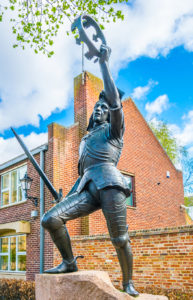REIMAGINING RICHARD III
The American Branch of the Richard III Society is proud to be a sponsor of the Wallace Collection’s upcoming exhibit, “The Lost King: Reimagining Richard III.” The exhibit will open in September 2022 at Hertford House, the London home of the Wallace Collection. The date is to coincide with the 10th anniversary of King Richard’s reburial and the UK premiere of the film “The Lost King,” about Philippa Langley’s quest for the burial site. Wallace collection Arms & Armour Curator Dr. Tobias Capwell served as Historical Advisor on the film.
Official press release by the Wallace Collection:
THE LOST KING: REIMAGINING RICHARD III

This temporary exhibition, the first ever to be mounted in the galleries of arms and armour at Hertford House, traces the long relationship between the Wallace Collection and King Richard III of England. Over more than a century, Wallace Collection works of art have played key roles in the evolution of the modern conception of Richard III – one of the most enthralling and enigmatic figures in British history. This special show, opening in the autumn of 2022 to coincide with the release of the film The Lost King, features artworks from the Wallace Collection alongside other manuscripts, paintings, sculptures and foremost, armour and costumes created for the new movie and kindly lent by Pathé.
THE STORY
King Richard III (1452-85) was the last English king to be slain in battle, his downfall at the Battle of Bosworth (22 August 1485) marking the end of over three hundred years of Plantagenet rule, and the ascendance of the Tudor Dynasty. Traditionally viewed as a usurper who seized the throne in 1483 after the death of his older brother, King Edward IV (1442-83), displaced the young King Edward V (1470-83?) and shortly thereafter, perhaps, assassinated him, Richard III has since become a source of passionate controversy. Sixteenth-century historians attributed diverse crimes to him, including multiple murders, recording his life as a tale of blood and destruction, a seductive yarn adapted, embroidered, and immortalised by Shakespeare in his play The Tragedy of King Richard III (c. 1592-4).
Since at least the publication of Sir George Buck’s The History of King Richard the Third (1619) and Horace Walpole’s Historic Doubts on the Life and Reign of King Richard the Third (1768) however, a movement developed to reconsider the life and reputation of a monarch who increasingly came to be seen as unjustly maligned and misunderstood. Attracting considerable interest, the effort to rehabilitate Richard III’s memory led to the formation of the Richard III Society in 1924. Since then, the popular fascination with Richard III has grown enormously.
Since at least the seventeenth century, Richard III has also, understandably, remained a popular figure in European art, with artists revelling in the visualisation of scenes from his life, or from (more usually) the Shakespearean version of it. One of the most celebrated pre-20th century Ricardian works of art is Paul Delaroche’s Edward V and the Duke of York in the Tower (1831). Now in the Wallace Collection, this dark and disturbing image promotes some of the most popular themes in the story of the ‘Princes in the Tower’.
In the 20th century, artworks in the Wallace Collection would continue to influence the ways in which Richard III was imagined and interpreted in wider culture. In the early 1950s, Sir James Mann (1897-1962; Director of the Wallace Collection 1946-62) served as historical advisor to Sir Laurence Olivier on the latter’s cinematic adaptation of Shakespeare’s play. This meant that arms and armour in the Wallace Collection provided primary design references for Richard III (1955), in which Olivier played the title role. Indeed, the star wore a copy of a Wallace Collection armour (inv. no. A21), rendered in black rubber, in the climactic battle sequence. The film was an international success, seen by millions of people across the world at the time, thanks in large part toits broadcasting on the new technology of television.
This version of Richard III, clad in a Wallace Collection armour, became perhaps the most iconic of all treatments of the character. Proof of the impact of Olivier’s film, and of the fame of Wallace Collection A21 can be found in the work of artists working later in the 20th century. When he created, in 1980, a new monument to Richard III in advance of the 500th anniversary of the Battle of Bosworth, the sculptor James Butler RA again used Wallace Collection A21 as his model for the king’s armour. This sculpture in turn became one of the most commonly recognised images of the king in his final moments.
When the grave of Richard III was discovered in Leicester in 2012, The Wallace Collection became involved when Curator of Arms and Armour Dr Toby Capwell was invited to the car park by researcher, Philippa Langley. Later Toby was asked to take part in the investigation of the king’s skeleton, the initial results of which were presented at a conference at Leicester University the following year. After the examination of the remains was completed, they were reburied at Leicester Cathedral, watched by 80,000 people in the city centre, and millions more via coverage by the international media. The royal coffin was closely guarded by two fully armoured horsemen, one of whom was Toby. Langley had proposed the King’s Honour Guard in 2013, which Toby would lead.
Four years later, in 2019, production began on the feature film The Lost King. Written by Steve Coogan and Jeff Pope and directed by Stephen Frears, the team behind the 2013 hit Philomena, this new British-made drama tells the story of the 2012 excavation in Leicester. Well-known for his research and publications on the history of armour in England, Toby Capwell was asked to serve as Historical Advisor on the film, following Langley’s recommendation. Although it is set entirely in the early 21st century, the culmination of the film involves an appearance of King Richard in full battle dress, surrounded by his knights and retainers. This dramatic climax provided Toby with a chance to create a new image of this fascinating and highly significant historical figure, based on decades of further research carried out since the previous cinematic treatment by Olivier and Mann in 1955. Drawing on objects in the Wallace alongside many other sources, Toby helped the production designers to create an entirely new interpretation, one that perhaps comes closer to the real historical reality than ever before.
THE FILM AND THE EXHIBITION
The Lost King will be released in cinemas in the late summer or early autumn of 2022, to coincide with the tenth anniversary of the discovery of the royal burial and remains (25 August / 5 September 2012). An opening shortly before the film’s premiere will allow the exhibition to benefit from the media attention generated by the film, and by the anniversary of the excavation. These, alongside the longer history of the Wallace Collection and Richard III on film, will undoubtedly provide further, more directed interest.
If you would like to help sponsor this exhibit, download this form and write “Richard III Exhibit” on the line for the project to direct your finds towards.
